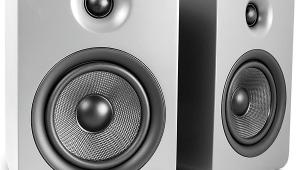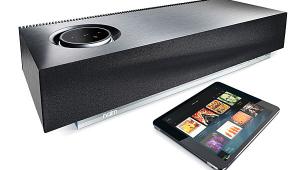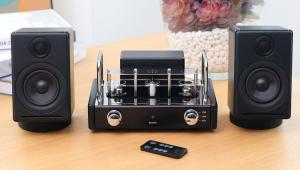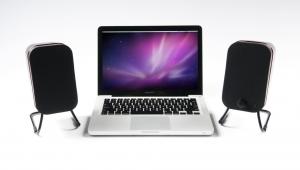Review: Libratone Live

Just three years after the iPod ruled the audio industry, manufacturers are starting to look on it as a quaint “legacy device,” one they have to accommodate for customers who just aren’t with it. The iPod’s being replaced as our primary music source by all sorts of wireless stuff, like smartphones, Bluetooth-equipped computers, and routers connected to network-attached storage (NAS) drives.
The introduction of Apple AirPlay last year is accelerating this trend. AirPlay lets you stream tunes from an iPhone, iPad, iPod touch or a computer running iTunes to any AirPlay-equipped device. That could be almost anything audio, such as an A/V receiver or a compact audio system like the new $699 Libratone Live, which I’ve been playing with for the last few weeks.
The Libratone Live delivers the two things I love most about Denmark: excellent audio engineering and quirky Scandinavian style. The style you can see. It’s an unusual combination of Apple-style white plastic and chromed accents, with a speaker grille made from a weird, almost mohair-like fabric that early ’70s bands with copious facial hair would have made vests out of. The Libratone logo is on a little sewn-in tag, like the Levi’s logo on a pair of jeans. The sole button on the unit has a line drawing of a bird backlit in white, glowing amber or red depending on the operating mode.
Weirder, but just as wonderful, are the guts. It’s a three-way stereo system, with a single 5-inch woofer powered by a 50-watt amp; two 3-inch midrange drivers, each powered by a 25-watt amp; and two small ribbon tweeters, each also powered by a 25-watt amp. What’s weird about it is that the midranges and tweeters point backward. They’re mounted on the two rear-facing sides of the triangle-shaped enclosure. The front of the enclosure behind the midranges and tweeters is left open, so the back wave from the midrange drivers can escape. (There’s a felt pad behind each tweeter to absorb its back wave.) The idea is to create a bigger, more spacious sound.
Libratone has a fancy trade name (FullRoom) for this driver arrangement, and claims a patent on it. However, this dipolar (blowing sound both ways, with the back wave out of phase with the front wave) arrangement for the midrange driver isn’t a new idea. It’s one that high-end speaker designers have been using for years — for a recent example, check out the higher-end models from Nola Acoustics. And electrostatic speakers work in a similar fashion.
Setup
Getting the Libratone Live to connect to my network wasn’t too tough. I had to go push a button on my router, and the little bird button flashed various colors at me while I looked through the manuals (there are four) to find out what each color meant, but in the end it all worked OK. If you unplug the Libratone Live and move it, it’ll get itself connected to the network again in about 30 seconds. Usually. Sometimes I had to go push that router button again.
Communication with my PC running iTunes wasn’t always so smooth. Occasionally I’d get an error message saying the computer wasn’t able to connect to the Libratone. I was always able to correct the problem by rebooting iTunes or unplugging and replugging the Libratone’s AC cord. The Sonos Play:3 and my various Bluetooth speakers connect to my stuff more reliably.
This brings up a limitation of AirPlay that some other systems don’t suffer: The Libratone Live is dependent on the source device to get its audio signal. Shut down the computer or take away the iPhone, and the Libratone Live goes silent. In contrast, the Sonos Play:3 connects all by itself to your NAS drives and the Internet. You just tell it what to do and as long as it has a network connection, it will keep on streaming.
Also, the Libratone Live lacks a volume control. If you want to turn it down real quick for a phone call, you have to grab whatever device it’s streaming from and turn down the volume through the controls in iTunes.
A Libratone iPhone/iPad app available through the App Store lets you enter information about your room, then fine-tunes the Libratone Live’s sound for the environment. Didn’t get a chance to test this, though — I’m a Droid guy.
The chromed metal handle makes the Libratone Live really convenient to haul around from room to room, or even outside. Kinda makes me wish it had a rechargeable battery inside.
- Log in or register to post comments

























































